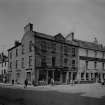Pricing Change
New pricing for orders of material from this site will come into place shortly. Charges for supply of digital images, digitisation on demand, prints and licensing will be altered.
Upcoming Maintenance
Please be advised that this website will undergo scheduled maintenance on the following dates:
Thursday, 9 January: 11:00 AM - 3:00 PM
Thursday, 23 January: 11:00 AM - 3:00 PM
Thursday, 30 January: 11:00 AM - 3:00 PM
During these times, some functionality such as image purchasing may be temporarily unavailable. We apologise for any inconvenience this may cause.
Forfar, 20 West High Street, Meffan Institute
Museum (19th Century)
Site Name Forfar, 20 West High Street, Meffan Institute
Classification Museum (19th Century)
Canmore ID 194389
Site Number NO45SE 188
NGR NO 45548 50601
Datum OSGB36 - NGR
Permalink http://canmore.org.uk/site/194389
- Council Angus
- Parish Forfar
- Former Region Tayside
- Former District Angus
- Former County Angus
Kirriemuir
All of the 18 carved stones and fragments came from the site of the old parish church and churchyard in Kirriemuir, and they testify to the existence in the early medieval period of a strong local school of sculpture. The distinctive features of its cross-slabs include crosses filled with bold interlace or diagonal key pattern, crosses with six-cord rings, figures wearing elaborately folded garments and a chair with bold zoomorphic terminals. Pictish symbols appear on two of the cross-slabs. These carved stones are now in the Meffan Museum and Gallery in Forfar (Canmore 194389), except for no 18 which is in the Gateway Museum in the old Town House in Kirriemuir (Canmore 32291).
Primary references: ECMS pt 3, 226-8, 258-61; RCAHMS 2003 Broadsheet 11.
A Ritchie 2019
Architect: Tait Conner and Henry Mitchell, Glasgow 1896
(Major Thomas Martin Cappon, unsuccesful competition design)
Publication Account (2004)
The overwhelming majority (of carved stones) are Christian, coming from the sites of parish churches, and the Dunnichen symbol stone, originally found covering a cist some distance from the parish church, appears unusual in this company. The collection from Kirriemuir, now running to eighteen, reveals a similar story of damage to that from St Vigeans, the cross-slabs having been broken up for reuse as building stones. As at St Vigeans, the range of sculpture is quite wide, and again it has been possible to reconstruct the designs of some of the smallest fragments, particularly with reference to more complete slabs within the collection (see illustrations 6, 16 and 18). For compariosn, a digitial scan of the possible ogham inscription found n the course of this work is reproduced here.
The survey has also thrown up the contrast between the areas of north and south of the Mounth. Here, to the south, the main weight of sculpture is Christian, associated with the sites of churches and chapels. Symbol stones are found, but they tend to be in other locations. In Aberdeenshire there are very few cross-slabs, by far the majority of the sculpture comprising rough slabs and boulders bearing symbols. And yet, in numerous instances these apparently pagan stones have been found in or near a churchyard.
Information from ‘RCAHMS Excursion Guide 2004: Commissioners' Field Excursion, Perth and Angus, 31 August – 2 September 2004’.






























































































